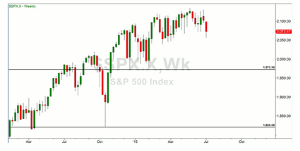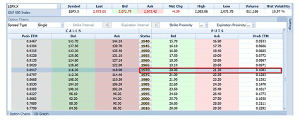What is the motivation for anyone to sell puts? Options instructor Russ Allen, of Online Trading Academy, outlines how the put seller makes money if—much like an insurance company—over time the total premiums received exceed the amount of claims paid.
In a previous article, I listed the various types of investment risks we are all subject to. I mentioned there that listed options give us ways to choose to avoid the market risk inherent in stocks, if we are so inclined, by buying put options. Put options are literally an insurance policy guaranteeing that we do not lose more than a specified amount of value from our stock position, no matter how far the prices of those stocks may fall.
What is the motivation of the person who sells the conservative investor those puts? Why are they willing to take on the risk that the stock owner seeks to avoid?
Anyone can sell puts, in fact, doing so is a strategy that can pay off very well for the individual investor. When an investor sells puts, he or she has sold insurance. Like any insurance company, the put seller makes money if over time the total premiums received exceed the amount of claims paid.
In this case, the put seller has knowingly accepted market risk. That is the risk that the price of stock could in fact go down below the strike price of the puts. In that case, the put buyer will undoubtedly exercise the put option. The put seller will then be forced to buy the stock at the strike price, which is now above the new lower market price. When the put seller liquidates that stock position by selling the stock at its now-lower market price, he/she will have a loss on the stock position. If this loss is greater than the amount of the premium received when selling the put in the first place, there will be an overall loss on the position.
The put seller is intentionally taking on this risk in exchange for a fair compensation. The put seller receives the put premium up front. If the stock price does not go down below the put’s strike price then that premium is the put seller’s to keep. The amount of the premium after commissions is then clear profit.
If the put seller chooses his/her risks carefully, then it is possible to make sizeable returns over time...just as an insurance company does.
Here is an example:
Above is a chart of SPY, the exchange-traded fund that tracks the Standard & Poor’s 500 Index.
On July 3, SPY stood at $206.90 per share.
A couple of previous major low points were visible at 1972.56 and at 1820.66.
NEXT PAGE: What Exactly Does Choosing Risk Correctly Involve?
|pagebreak|An investor who believed that the S&P 500 was unlikely to drop below the nearest major low by August could have sold put options near that strike price. Below is the option chain for the August 21 SPX options:
Note that the puts at the 1970 strike had a Bid price of $20.00 and an Ask price of $21.30. The puts could have been sold near the midpoint between the two prices, at around $20.65. All numbers on the option chain need to be multiplied by 100 to get the amounts applicable to one option contract. So selling one of these 1970-strike puts would bring in $20.65 X 100 or $2065.
Since this put position would obligate us potentially to buy the underlying asset at 1970, we would have to have $1970 X 100 or $197,000 cash available in our brokerage account in order to sell the puts on a fully secured basis.
Our maximum return on this $197,000 investment would be the $2065 premium received. This is a raw rate of return of $2,065/197,000 or 1.05% in 50 days. This works to an annualized yield of 6.8%.
If the S&P does drop below 1970, then the put seller would be liable for any difference between 1970 and the level of the index at the August expiration. Since the underlying instrument for these options is the index itself—which is just a mathematical calculation—the put seller will not be able to buy the underlying asset. The options on an index cannot be settled by delivery of the underlying asset since the index is not a thing that can be owned. Index options are cash-settled options. So, at expiration, the put seller would have an amount of cash removed from his/her account equal to the difference between the strike price (1970) and the value of the index at that time. If the index were at 1960, for example, then an amount of cash equal to (1970 – 1960) * $100—or $1,000 total—would be removed from the put seller’s account and transferred to the account of a put buyer.
In this case, where the index ends up at expiration just slightly below the strike price, the put seller still has a profit. He/she has to give up $1,000 at expiration in this example, but $2,065 was originally received when the put was sold. So, the put seller’s net gain on the trade is $2,065 – $1,000 or $1,065. For the put seller’s entire premium to be given back, the index would have to fall below 1970 by the full 20.65 originally received for the put, which would be all the way to 1959.35.
If the index did fall below this break-even point of 1959.35 by the August expiration, then things would get worse in a hurry for the put seller. He/she would thereafter be losing another $100 for every additional one-point drop in the index.
That is the market risk that the put seller takes on. The career of a put seller is a large number of small profits punctuated by occasional large losses, just like an insurance company. And, like an insurance company, if we choose our risks intelligently, our profits will exceed our losses.
Choosing our risks correctly involves skillfully analyzing price action to pick the right strike prices for our option trade. This is a skill taught in our Market Timing classes. If you have not taken one, contact your local center and sign up.
Next time we’ll see how the put seller can buy some insurance of his or her own and trade in some of that market risk for something else.
By Russ Allen, Instructor, Online Trading Academy























